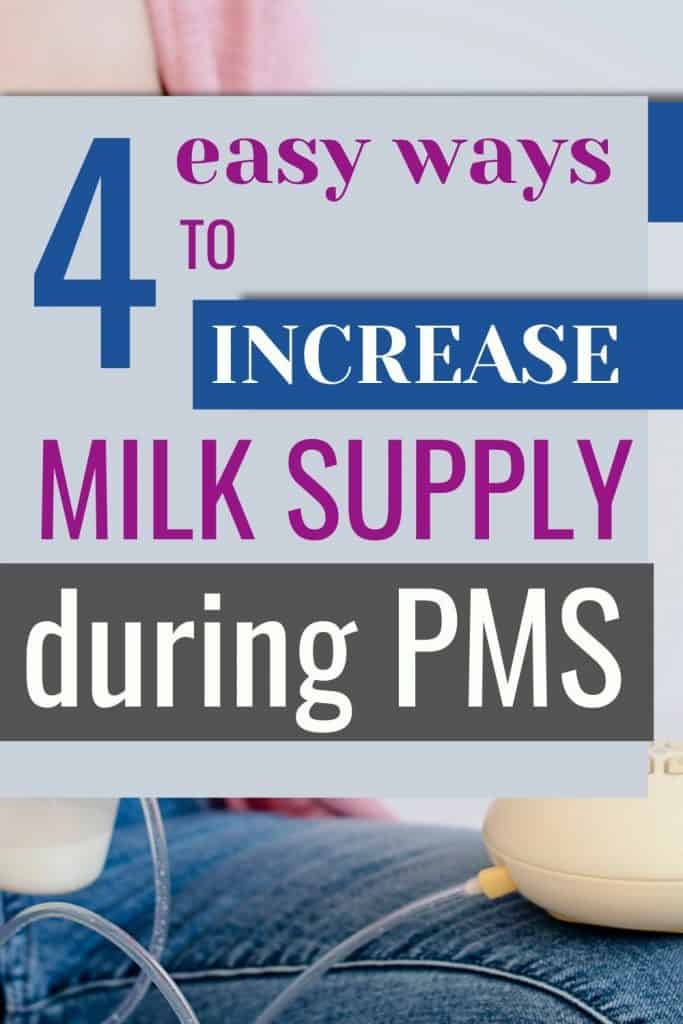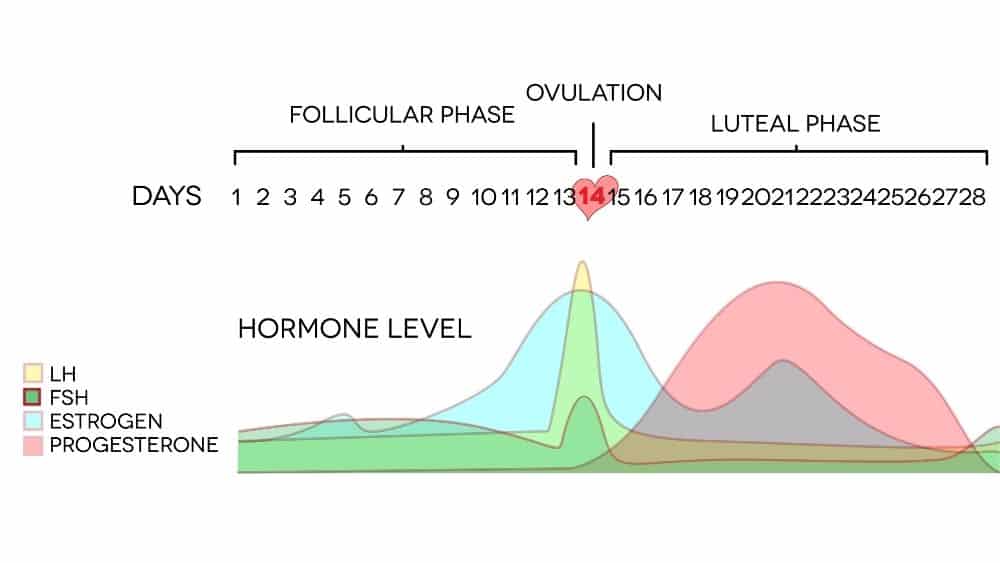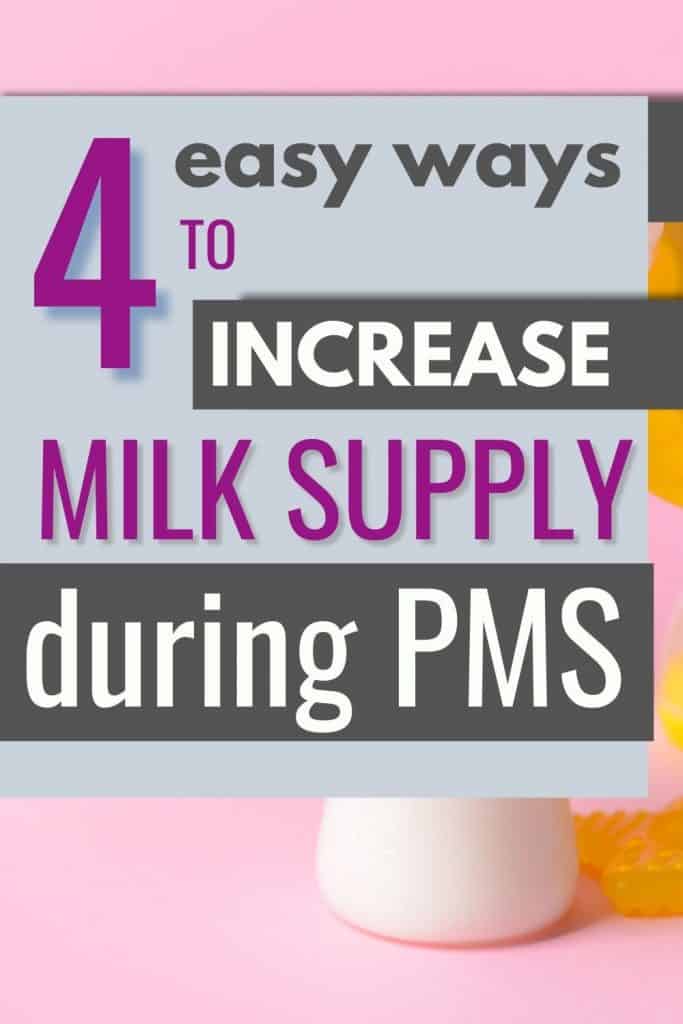Has your milk supply suddenly dropped, all while you’re starting to feel cranky, bloated, or crampy? Don’t panic that your milk is gone; you may just be dealing with PMS. It’s important to learn why your milk supply drops during your period (or PMS).
Disclosure: This article contains affiliate links. As an Amazon Associate I earn from qualifying purchases. You can read my full policy here.
Fortunately, this supply dip is temporary, and there are things you can do to help some. Read on to learn more about how to combat the milk supply drop during your period.
Table of Contents
When does your period return while breastfeeding?
Some lucky (well, assuming they’re not TTC) moms simply don’t have a period while they’re breastfeeding. I’ve heard of moms who go for years with no period because they’re nursing their toddler.

Others get their cycle back within a few months of birth, even if their baby is exclusively nursing. My cycle always came back within 9-12 weeks postpartum, even with exclusive breastfeeding. The worst.

(BTW, regardless of whether your cycle has started up again, don’t trust that you’re not fertile just because you haven’t had a period yet after 6 months postpartum. Exclusive breastfeeding at least every 3-4 hours in the day and at least every 4-6 hours at night grants 98% effective birth control ONLY for the first six months postpartum. There’s always the chance that you’ve ovulated and just haven’t seen your period show up yet.)
NOTE: If you think you’re dealing with PMS but you’re actually pregnant, that could also affect your supply. Milk supply will begin to taper off by mid-to-end of your first trimester or so, and you will probably stop producing milk (roughly) around 20 weeks. But you can still nurse for comfort.
RELATED: Breastfeeding during pregnancy – What you need to know
Some moms get “phantom cycles.” Basically, you get all the symptoms – cramping, mood swings, etc. – but Aunt Flo never comes. After my fourth child, I had a combination of an early return of my cycle with phantom periods. I would switch back and forth between a real period and a phantom cycle each month.
Does your period affect breastfeeding?
Your period can affect breastfeeding in several ways.
First of all, your milk supply may drop just a few days before menstruation starts. While this is only temporary, it can definitely make you nervous (especially if you’re pumping and see less milk than usual).
For this reason, your baby may want to nurse more often right before your period. Of course, that might be a welcome way for you to relax and lounge in bed while you breastfeed your baby!
However, you might feel irritated or like your skin is crawling when your child nurses. If that’s the case, you might have nursing aversion. This makes breastfeeding during your period unpleasant. Fortunately, a lot of the remedies for nursing aversion also help with PMS and menstrual symptoms.
RELATED: Nursing aversion – When breastfeeding isn’t magical
Even if you don’t have nursing aversion, you may still have nipple tenderness (much like you did when you were pregnant). This can make breastfeeding more difficult as well.
Regardless of what your cycle does, though, it can affect your breast milk output.
Does milk supply decrease with your period?
Your body’s hormones are always changing to support different phases of your cycle. Estrogen is highest during the first half of your cycle (before ovulation), while progesterone dominates during the second half. However, these two hormones aren’t what directly affect milk production levels.

The changes in estrogen and progesterone levels affect the levels of calcium in blood serum. Serum concentration of calcium is lowest before your period. And since low serum calcium levels reduces milk production, your supply can dip before your period.
With that said, your child may nurse more often right before your cycle starts, but they should still get plenty of milk.
RELATED: How to know if my breastfed baby is eating enough
Does breast milk taste different during your period?
Moms of older nurslings might get told that their milk tastes funny right before their cycle hits. There’s a reason for this!
RELATED: Benefits of toddler nursing
RELATED: Breastfeeding a 1 year old
Milk composition changes somewhat right before your period. Sodium chloride (salt) concentrations go up, and lactose (milk sugar) goes down. This makes milk possibly taste saltier or less sweet. While a toddler can complain about the change, infants aren’t able to verbally describe this change, but they can still make it clear that they aren’t happy.
Infants may be cranky about nursing during your PMS and the first day or two of your cycle, turning their head to the side and refusing to latch. Or they might act fine and never complain.
Is your baby fussy during menstruation?
If your baby is fussier right before your period (or during your period), it’s normal! There’s a few reasons this may be the case.
As mentioned above, your breast milk composition changes to taste saltier and less sweet right before your period. If your baby is more of a little gourmet, they may notice and complain about the taste.
Or, their fussiness may be simply due to your (temporarily) lower supply. They want to nurse more frequently, and that’s okay.
Much like with the dreaded “sleep regressions,” your baby nursing more frequently actually serves a purpose. This helps bring your supply back up so it can be strong a few days later after your cycle calms down.
How to increase milk supply during your period
Fortunately, there are several simple steps you can take to increase your supply during (and right before) your period.
Calcium and magnesium for breastfeeding
Since a dip in calcium is a large part of the problem, a calcium supplement during the second half of your cycle can keep your supply strong. In fact, the Womanly Art of Breastfeeding states that 500-1000mg of calcium and magnesium from ovulation (around day 15 of your cycle) through the first three days of your period can help minimize supply drops.
You’re best off taking a combined calcium / magnesium supplement (Just taking an antacid, which is made of calcium carbonate, doesn’t help much because the calcium is not well-absorbed by the body). This brand is a perfect choice because it’s at a good ratio of calcium to magnesium and it’s in the right form for your body to use.
Use breast compressions
Breast compressions, both during nursing and pumping, can help you get every last bit of milk out. Plus, over a few days, it can actually increase your supply.
This video, from Stanford University, does a great job of showing technique for breast compressions (yes, it shows breasts in the video, so it’s “adult content”).
Continue nursing and snuggling your baby
Nursing and skin-to-skin contact with your baby, though, increases oxytocin and thereby tells your body to make more milk. So cuddle up with your baby, draping a cover over both of you (Bonus: They’re like a built-in heating pad if you’re feeling crampy), turn on your favorite comfort show on Netflix, and just relax.
(NOTE: Do NOT fall asleep with your baby on a sofa. If you think you’re going to fall asleep with your baby, your bed is a much safer place to be.)
RELATED: Bed sharing safely
If you feel well enough for a gentle walk, tuck your baby in your favorite carrier and go.
Note: Sometimes when you get nervous about your supply, you may be tempted to “top off” your baby with formula. But that’s probably not necessary.
The bigger problem with “topping off” is that, when done often enough, it can cause a more permanent drop-off in your supply. Breast milk production is based on supply and demand, so if you lower the demand by supplementation, you end up telling your body to produce less milk.

Pump longer
If you’ve watched yourself breast pumping, you may have noticed your “let down.” You may feel tingling or warmth in your breast (or you may not), and then you’ll see that you’re releasing much more milk than you were before.
You can have more than one let down per pumping session, you just have to pump a bit longer. You can help stimulate a second milk ejection reflex by breast stimulation, smelling a onsie your baby wore, or even by just looking at pictures or videos of your baby.

A few moms (like me) get better milk output when they watch the bottles fill up. It’s like once I see those first few drops, I’m encouraged that my body is doing what it’s supposed to so I have a let down.
Most moms (especially during supply dips such as during PMS) pressure themselves about how much milk they see in the bottle. For them, watching the bottle is a source of stress that inhibits the milk ejection reflex.
If that’s you, bring a pair of baby socks in your pumping bag. Put the socks on your bottles while you pump so you can’t watch. It’ll take the mental pressure off so you can relax.
Stay hydrated
Some mothers report a big difference in their milk supply based on how well hydrated they are. Plus, drinking enough water makes a big difference in your mood (really!), your ability to focus, your digestive health, and basically everything else.
As a breastfeeding mom, I was told to drink 90 oz water per day. Of course, check with your doctor for your specific recommendation, but this number was based on how much water most women are advised to drink per day (64 oz) plus another quart (32 oz) for breastfeeding moms.

Galactagogues for milk supply during your period
Many sites will recommend specific foods or supplements for milk production, like oatmeal or fenugreek tea. And for some moms, these foods really make a difference (here’s some milk-boosting recipes from a friend and certified Online Health Coach whom I really trust).
While there’s nothing wrong with those things, they can distract you from what’s most important in keeping up your supply – keep emptying your breasts and keep snuggling your baby.
So if milk boosting smoothies, overnight oats, or another yummy recipe works for you, enjoy it. Just don’t forget the basics of skin-to-skin and frequent emptying of the breast.
Conclusions on dealing with a milk supply drop during your period
I hope these tips encourage you if you’re dealing with a low milk supply around your period.
The biggest takeaway: This supply dip is temporary. Don’t panic and just keep nursing your baby. Your breast milk output will come back up in a few days after PMS and the first day or two of your cycle is over.
And if you want more support, make sure you grab a copy the ” target=”_blank” rel=”noopener” title=””>Breastfeeding 101 Quick Start guide.

